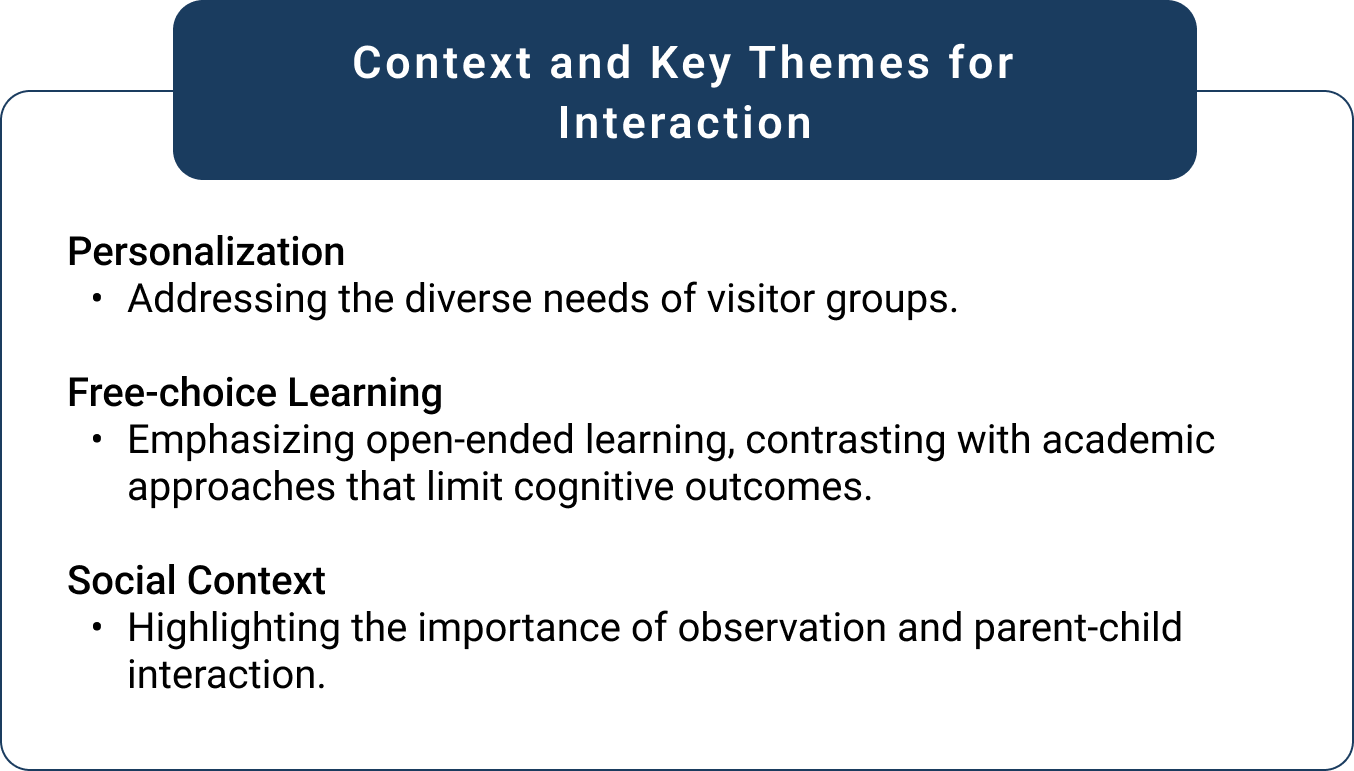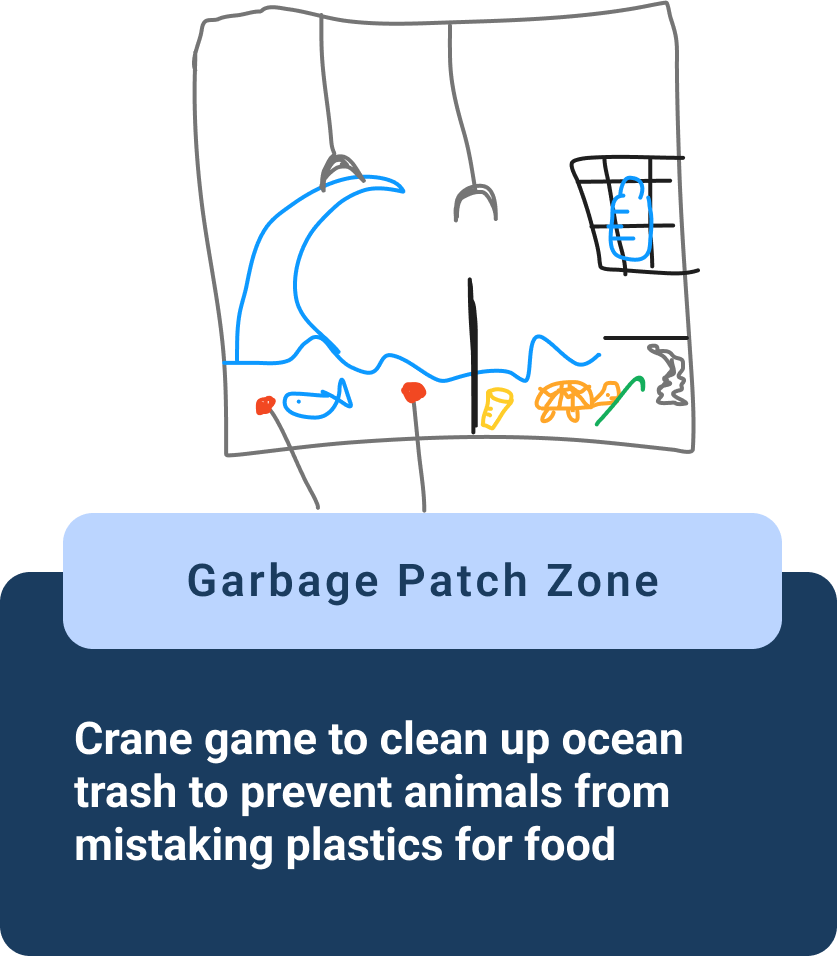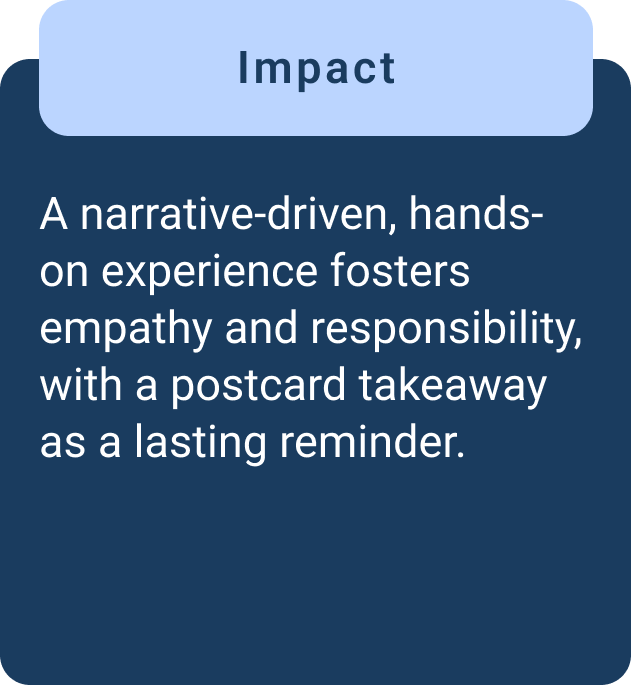Discovery Cube
DISCOVER | DEFINE | DEVELOP | DELIVER
Overview: Designed an interactive Ocean Encounter exhibit that transforms kiosk-based education into tangible, hands-on experiences, engaging visitors to deepen their understanding of ocean conservation and inspire environmental stewardship.
Role: Product Designer, Lead UX Researcher
Toolkit: Figma, FigJam, Illustrator
Background
What is the Discovery Cube?The Ocean EncounterScience children’s museum opened in June of 1998 with large-scale hands on exhibits that focus on STEM (Science, Technology, Engineering, Math) Proficiency, Environmental Stewardship, Early Learning, & Healthy Living.
An interactive aquatic wonderland where you’ll explore the zones of the ocean including Sunlight Zone, Twilight Zone, Midnight Zone, Abyss, and Trenches, each showing different aspects of ocean life and the threats they face from human activity.
Client Problem: Lack of a Human-Centered Design Approach
According to Discovery Cube’s Impact Pyramid, the current experience falls short in addressing the "Elevate" and "Impact" sectors, which are crucial for inspiring environmental stewardship and meaningful visitor engagement.
Our Objective: Transformed Exhibit Experience
An interactive and immersive Ocean Encounter exhibit experience that inspires deeper learning and understanding of key ocean issues while elevating visitors’ commitment to environmental stewardship.
The Method
Competitive Analysis
Identified competitors with value propositions similar to The Discovery cube, specifically exhibits within these museums that aim to not only educate, but to inspire and impact through added immersiveness and interactivity.
Literature Review
1. Understanding the Museum Space
2. Narrowing the Focus: Expert Insights
Defining the Direction
With a clear focus on assemblies, we conducted deeper research into their strengths and applications in museum settings.
Initial Stage: Setting the Foundation
We began by exploring key themes and interaction frames to gain a foundational understanding of how museums design and implement visitor experiences.
Guided by Expertise
To refine our focus, we consulted Dr. Lauren Vargas, a museum expert with extensive experience in community and collaboration strategies. She pointed us to pivotal studies that emphasized narrative-driven and tangible interaction over mobile solutions.
3. Assembly Interaction Frames: Key Components
Why Assemblies?
Effective for larger sites with multiple exhibits.
No set sequence of interaction, allowing visitors flexibility.
Encourages collaboration and social interaction.
Exploring the Current Exhibit Experience
Our team analyzed the Ocean Exhibit layout and interactive kiosks to understand the current experience. We found that the kiosks provided educational content about each zone—Twilight and Midnight, Coral, Kelp Forest, Abyss, Open Ocean, and Garbage Patch—highlighting threats from human activity and actions for ocean conservation. Visitors engaged in a scavenger hunt using either their own devices or a provided paper pamphlet to explore the exhibit.
Co-Creation with Stakeholders: Refining the Exhibit Experience
Snapshot: Co-creation Session 1 & 2
Session 1: Boat Activity EvaluationIn these co-creation sessions, I facilitated collaborative workshops between our design team and museum stakeholders, providing new insights and echoing takeaways from our previous research.
Session 2: Synthesize and strategizeActivity: Stakeholders identified likes, dislikes, and aspirations.
Activity: Grouped feedback into themes and collectively developed solutions for challenges and elaborated on ways to achieve the goals and vision of the exhibit.
Data Collection: In-Person Observations and Interviews
We aimed to gather detailed insights into visitor engagement, interactions, and experiences within the exhibit space to identify areas for enhancement.
MethodologyKey Observations
Over a three-day research period, we conducted in-person observations of visitor behavior across the exhibit and the museum and held interviews with visitors and staff members
Physical Space Design
• The open layout offers minimal visitor guidance, which can feel overwhelming.• Kiosks and activities create congestion in some areas, leaving others underutilized.
Visitor Demographics
• Younger children, 2-6 years old
• Older children, 7-12 years old
• Adults
Engagement & Education
• Limited engagement with kiosks and information-dense signs.• Treasure hunt activity is underutilized.
Floor Plan Mapping and Analysis
To visualize visitor behavior, we mapped two sets of floor plans to understand movement patterns and engagement levels
Engagement-focused floor plans revealed that hands-on zones saw peak engagement, while less interactive zones struggled to capture prolonged attention.
Synthesizing and Analyzing Data
GoalMethodologyConsolidate and analyze data from interviews and observations to uncover key insights guiding the design direction.
Conducted a four-pass analysis using affinity mapping in Figma to synthesize findings and uncover problem and opportunity areas.
1. Bringing the Data Together
Consolidated all data points from interviews and observations into a single shared space (Figma), using sticky notes and a categorization key.
2.Categorizing
Organized the data into “People” and “Space” groups and mapped onto the exhibit layout for better visualization.
3. Identifying Key Themes and Patterns
Data from the “People” and “Space” categories was consolidated onto a single map, uncovering how patterns like “Interactivity” and “Educational Impact” correlated with aspects of the exhibit.
4. Extracting Insights
Data from the “People” and “Space” categories was consolidated onto a single map, uncovering how patterns like “Interactivity” and “Educational Impact” correlated with aspects of the exhibit.
Key Takeaways
Co-Creation with Stakeholders: Aligning on Interaction and Ideation
To conclude our research, we facilitated two co-creation sessions with museum stakeholders. These sessions laid the groundwork for ideation by fostering alignment on key themes and envisioning interactive experiences.
Snapshot: Co-creation Session 3 & 4
Session 3: Defining Interaction and ImmersionSession 2: Synthesize and strategizeActivity: Stakeholders answered targeted questions regarding interactivity and immersion, two recurring themes from our research.
Using two visitor personas created with stakeholder input, we split into groups for a design challenge. Group 1 developed solutions without using technology, while Group 2 exclusively used technology-based approaches. After analyzing the ideas, we identified common factors across all solutions.
Our Opportunity
Making education tangible and interactive
• Education currently nested within kiosks can be transformed into hands-on activities.
• Kids naturally gravitate toward playful elements, correlating with the most visited exhibit areas.
Engage both parents and kids
• Incorporating tangible interactions creates shared experiences that engage parents and children.
• Shared excitement can foster greater interest in ocean conservation and individual impact on the environment.
We revisited our project objective, refining our focus to ensure the intervention would align with key goals for the exhibit experience.
Ideation
With research insights and co-creation takeaways in hand, we moved into the ideation phase. Our focus was to develop solutions aligned with our guiding principles—interactive, physical, narrative, and impactful.
Selected Solution: A narrative-driven solution connecting interactions across exhibit zones.
With stakeholder alignment secured we transitioned into refining the solution.
Iterating the Solution
1. Brainstorming Interactive Zone Experiences
We began by examining the current kiosk displays to identify ocean issues in each zone and sketched out ways to elevate these issues through interactive, gamified solutions.
We also began sketching initial designs for the takeaway postcard that would collect stamps at each zone.
2. Iterating on Designs
After presenting initial sketches to stakeholders, we narrowed our focus to four key interactions.
We incorporated cause and effect interactions, which proved to be beneficial throughout our research, and really leaned into games that we’ve played as kids and still find entertaining as adults
Final Delivery
Our final product for the Ocean Encounter exhibit featured interactive activities across four unique zones, each led by an animal mascot.
The experience begins with a postcard introducing guests as oceanographers on a mission to help marine life. The postcard includes an activity overview and spaces for stamps earned after completing tasks in each zone, serving as a field notes keepsake.
We developed physical prototypes of the postcard and stamps, featuring each zone's animal mascot, to ensure a tactile, engaging experience that ties the narrative together.
Click the button below for an in-depth look at our final delivery!
Idea Outcome
Our solution ties directly to the project objective: to create an immersive, interactive, and physical Ocean Encounter exhibit that uses narrative to inspire deeper understanding, learning, and impact on ocean issues while fostering environmental stewardship.
Fulfilling Stakeholder Criteria
Our solution meets all seven key criteria identified during the final co-creation session with stakeholders:
Next Steps
Create Physical Prototypes of Proposal Ideas
Complete User Testing on Proposal Ideas
Develop Digital Expansions for each exhibit
Create Interactive Experiences for the rest of the exhibit areas





























































